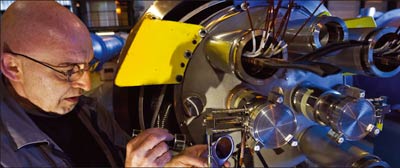
The consolidation campaign for the LHC, which aims to ensure a safe final commissioning and reliable running of the collider is now well under way. On 9 February CERN’s management confirmed the restart schedule for the LHC resulting from the recommendations from the previous week’s Chamonix workshop.
After the incident in September 2008, magnets were immediately prepared to replace those damaged. Now consolidation work is underway to ensure a safe and reliable restart of the LHC later this year. the experiments have adequate data to carry out their first new-physics analyses and have results to announce in 2010. The new schedule also permits the possibility of lead–ion collisions in 2010.
In Chamonix there was consensus among all the technical specialists that the new schedule is tight but realistic. According to CERN’s director-general, Rolf Heuer, “The schedule we have now is without a doubt the best for the LHC and for the physicists waiting for data. It is cautious, ensuring that all the necessary work is done on the LHC before we start up, yet it allows physics research to begin this year.” This new schedule represents a delay of six weeks with respect to the previous schedule, which foresaw the LHC “cold at the beginning of July”. This delay arises from several factors such as the implementation of a new enhanced protection system for the busbar and magnet splices; installation of new pressure-relief valves to reduce the collateral damage in case of a repeat incident; application of more stringent safety constraints; and scheduling constraints associated with helium transfer and storage. The new pressure-relief system has been designed in two phases. The first phase involves the installation of relief valves on existing vacuum ports in the whole ring.
Calculations have shown that in an incident similar to that of 19 September 2008 – which damaged magnets in sector 3-4 – the collateral damage would be minor with this first phase. The second phase involves adding additional relief valves on all of the dipole magnets, which would guarantee minor collateral damage (to the interconnects and super-insulation) in all worst cases over the life of the LHC. The management has decided for 2009 to install the additional relief valves on four of the LHC’s eight sectors, concurrent with repairs in the sector 3-4 and other consolidation work already foreseen. The dipoles in the remaining four sectors will be equipped in 2010.
On 18 February, Steve Myers, Director for Accelerators and Technology, reviewed the discussions on the LHC that took place at Chamonix at the public session of the LHC experiments committee. In particular, he described the scenarios that were studied to implement the consolidation measures and resume operation. He also explained that the schedule ultimately adopted will make it possible to obtain more physics data sooner, even though the energy will be limited during this first period to 5 TeV per beam to ensure completely safe operation. During the last week of February the enhanced quench protection system had a full review from a panel made up of experts from other high-energy physics laboratories from around the world, including the Brookhaven National Laboratory, DESY, Fermilab and the international fusion project, ITER. The enhanced protection system measures the electrical resistance in the cable joints (splices) and is much more sensitive than the system existing on 19 September.
The system has two separate parts: one to detect and protect against splices with abnormally high resistance; the second to detect a symmetric quench. The planning schedule was reviewed to define priorities between these two parts, both of which need to be complete before the restart at the end of September. The review also covered areas such as the technical details of the implementation of the new system, how well it will perform during operation and how “robust” it will be after years of service. In the preliminary report the panel found that: “The machine-protection staff have demonstrated a deep understanding of the issues involved in the design of the high-resistance-splice detection system.” It has “full confidence that the new system will have the ability to give early warnings for suspicious splices measured at the level of 1 nΩ” and that “the symmetric quench protection system, once its design is complete, will be able to detect quenches at twice the normal detection level”.
Further reading
• For a film of Steve Myer’s presentation at the open session of the LHCC, see http://indico.cern.ch/conferenceDisplay.py?confId=51221 and for all the presentations see http://indico.cern.ch/conferenceOtherViews.py?view=standard&confId=52248.
• For up-to-date news, see The Bulletin at http:/cdsweb.cern.ch/journal/.








